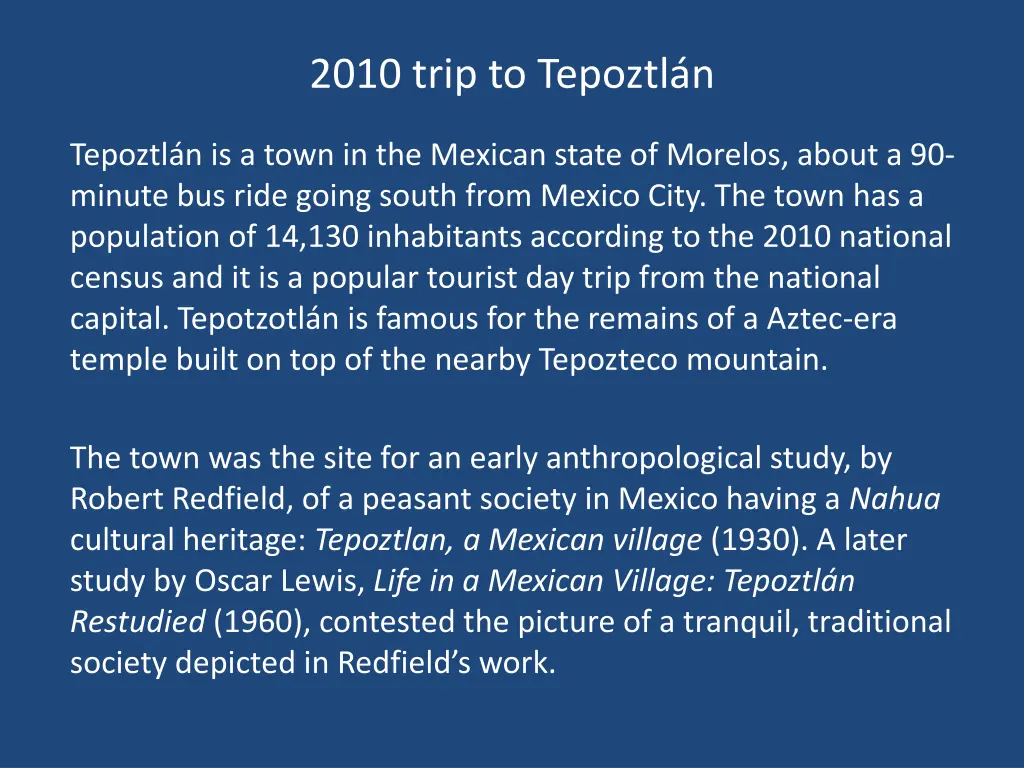
Discover Tepoztlán: A Historic Mexican Town
Explore Tepoztlán, a charming town in Morelos, Mexico, known for its Aztec-era temple, vibrant markets, cultural heritage, and local artistry. Immerse yourself in the lively streets lined with shops, visit the colonial church, and experience the unique offerings of this popular tourist destination near Mexico City.
Download Presentation

Please find below an Image/Link to download the presentation.
The content on the website is provided AS IS for your information and personal use only. It may not be sold, licensed, or shared on other websites without obtaining consent from the author. If you encounter any issues during the download, it is possible that the publisher has removed the file from their server.
You are allowed to download the files provided on this website for personal or commercial use, subject to the condition that they are used lawfully. All files are the property of their respective owners.
The content on the website is provided AS IS for your information and personal use only. It may not be sold, licensed, or shared on other websites without obtaining consent from the author.
E N D
Presentation Transcript
2010 trip to Tepoztln Tepoztl n is a town in the Mexican state of Morelos, about a 90- minute bus ride going south from Mexico City. The town has a population of 14,130 inhabitants according to the 2010 national census and it is a popular tourist day trip from the national capital. Tepotzotl n is famous for the remains of a Aztec-era temple built on top of the nearby Tepozteco mountain. The town was the site for an early anthropological study, by Robert Redfield, of a peasant society in Mexico having a Nahua cultural heritage: Tepoztlan, a Mexican village (1930). A later study by Oscar Lewis, Life in a Mexican Village: Tepoztl n Restudied (1960), contested the picture of a tranquil, traditional society depicted in Redfield s work.
Tourism is controlled with large buses leaving people at a small terminal just outside of town. Vans come every 5 minutes to shuttle people into the plaza of Tepotztl n.
The main road is lined with shops and houses leading into the central plaza with a daily market and a large colonial church. Even on a weekday there are crowds of people and dozens of taxi cabs at the plaza.
Fancy shops selling jewelry and clothing and small spas and boutique hotels can be found in Tepoztl n.
Artistic link to a pre-Hispanic heritage This mural on the entrance to their Catholic church proclaims a proud pre- conquest heritage. These works of art are created each year entirely out of different-colored local seeds. A variant of this kind of folk art, constructed of local flowers and plastic toys, is seen in Chapter 8 within the video of the Patron Saint s Fiesta in Amanalco. See a short video, Tepoztlan - "The Language of the Seeds" about Tepotztl n s folk art at: http://www.youtube.com/watch?v=svf AX9CzQm4
Across from the church is a large daily market with local produce and manufactured items
This includes a wide variety of herbal medicines The red signs, from left to right, claim that these herbs cure liver and digestive problems, circulation issues and diabetes.
A major attraction is the Aztec-era temple to Tepoztecatl, the god of pulque (an alcoholic beverage made from the sap of the agave cactus) on a mountain ridge overlooking Tepotzotl n.
The local myth of Tepoztecatl tells of a protector man-god who was both a pre- Hispanic leader and a diety. As in Amanalco, with its mythology about the man-god Nezahualc yotl (see chapter 9), both of these beings are key sources of unity and resistance to outside incursions into their environment. For more information on the myth of Tepoztecatl see: www.docfilm.com/webpages/Mexico/DefOfP pl.html






















